Bassdozer's Heavy Duty Flip 'n Swim Jigs Rule!

by Russ Bassdozer
This shows and tells product photos, product descriptions and
information for the lure models and colors that are (or have
been) available at BassdozerStore.com. Not all models and colors
shown are currently available, and exact specifications are
subject to change.
Note: Some of the following configurations may not all be
currently in stock. Some may be sold out at this time. Please
check online at www.BassdozerStore.com
for current availability of specific items below. Thank you for
your business.
Bassdozer Heavy Duty Flip 'n Swim Jigs
Bassdozer's heavy duty Flip 'n Swim combines two of the most
productive grass fishing tactics:
- Flipping/pitching jigs in grass and
- Swimming jigs over and through grass
- Now combined into a single power fishing presentation. Please
enjoy!
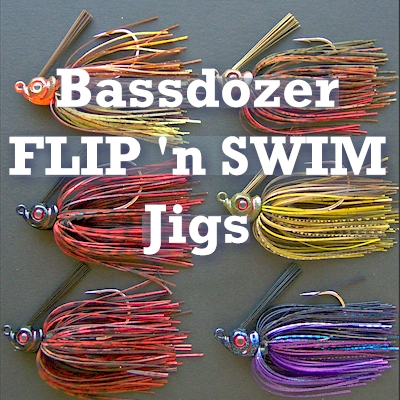
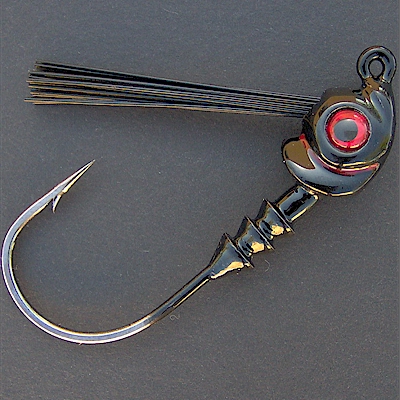

Bassdozer Heavy Duty Flip 'n Swim Jig ~ Rusty Red Craw
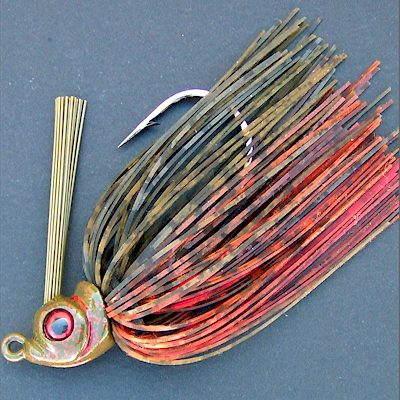
Bassdozer Heavy Duty Flip 'n Swim Jig ~ Rusty Green Craw
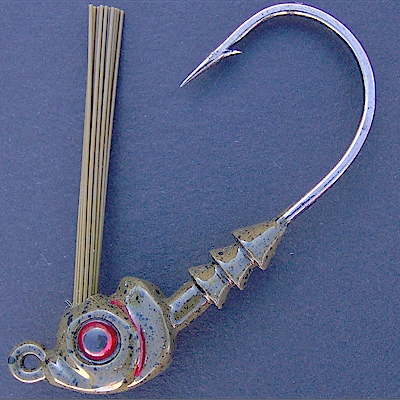
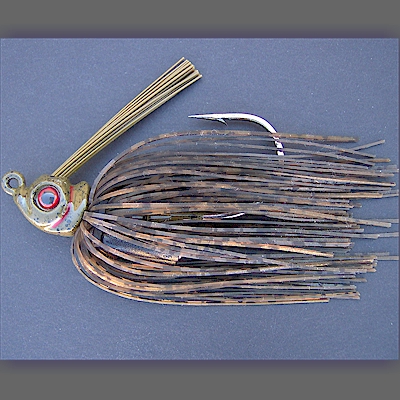
Bassdozer Heavy Duty Flip 'n Swim Jig Head ~ Green Pumpkin


Bassdozer Heavy Duty Flip 'n Swim Jig ~ Brown Purple

Bassdozer Heavy Duty Flip 'n Swim Jig Head ~ Black Blue

Bassdozer Heavy Duty Flip 'n Swim Jig Head ~ Brown Sunfish
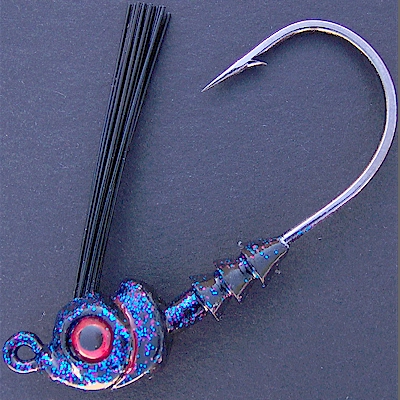

Bassdozer Heavy Duty Flip 'n Swim Jig Head ~ June Big

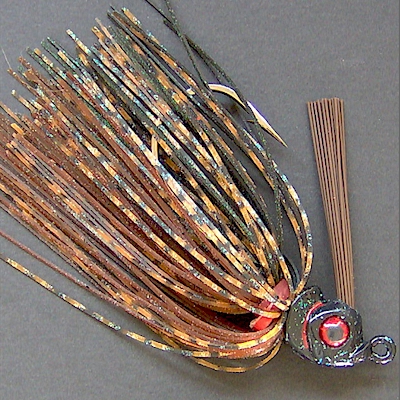
Bassdozer Heavy Duty Flip 'n Swim Jig ~ Black Brown Craw
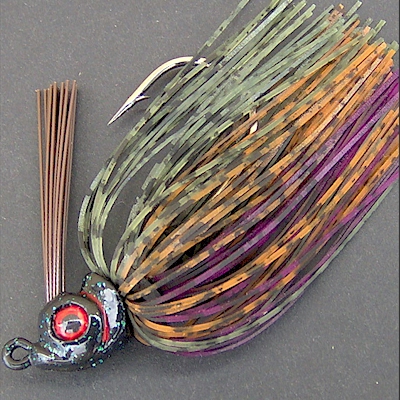
Bassdozer Heavy Duty Flip 'n Swim Jig ~ Watermelon Candy Sunfish
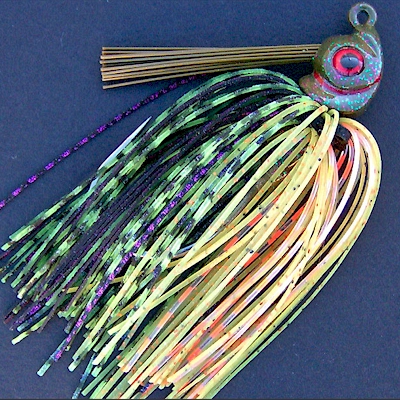
Bassdozer Heavy Duty Flip 'n Swim Jig ~ Bluegill

Bassdozer Heavy Duty Flip 'n Swim Jig ~ Green Sunfish
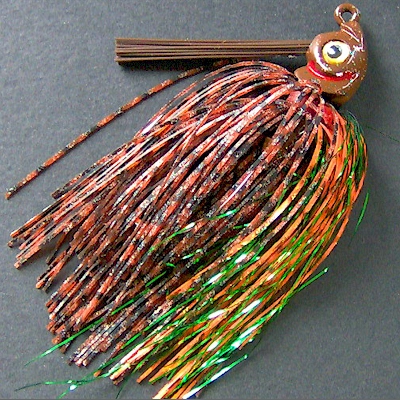
Bassdozer Heavy Duty Flip 'n Swim Jig ~ Brown Sunfish
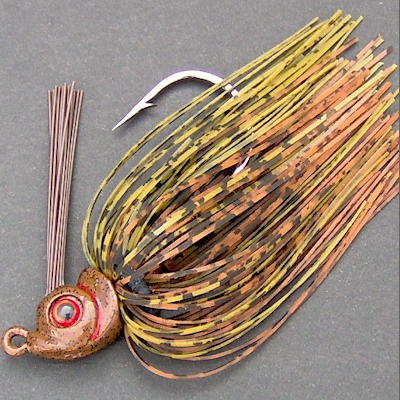
Bassdozer Heavy Duty Flip 'n Swim Jig ~ Olive Brown Craw

Bassdozer Heavy Duty Flip 'n Swim Jig ~ Warmouth Sunfish

Bassdozer Heavy Duty Flip 'n Swim Jig ~ Natural Frog
Flipping Jigs Rule!
People often ask, "What is flipping?"
The definition of flipping includes:
- an eight foot rod you could yank a beached boat off a sand
bar with,
- plus a winch to match (I mean reel),
- about 15 feet of rope off the spool (and 5 more on the reel
for backing),
- a strong back and biceps.
Oh, yes, you'll also need a flipping jig that won't crumble
under that kind of pressure.
Season after season, an analysis of winning techniques shows
that flipping jigs remain one of the most winningest baits on top
level pro tours like BASS and FLW. It's always been a winner and
always will. Who knows why, but big bass favor flipping jigs.
It's not just top tour pros either. Right on down the line of any
and all regional and local tournament trails, no matter where,
the flipping jig is indubitably a winner. If you look at any
regional or local tournament dominator, chances are more than
good that the flipping jig is the tool used to win time after
time.
For many anglers, however, it's a hard lure to use, and you
will not catch as many fish. If you do catch five bass (a limit),
or if you just need to hang one good kicker to win, the flipping
jig catches bigger bass on average than most any other lure. Who
knows why, but it does. The flipping jig always has and will be a
tournament-winning bait.
Around thick grass beds, reed berms, flooded brush banks, lily
pads and the like, a streamlined bullet-nosed flipping jig has
traditionally been high on an expert angler's options. I say a
flipping jig is for an expert angler, because as deceptively
simple as a flipping jig appears to be, it is difficult for a
neophyte to use one.
One problem is, many anglers underestimate the heaviness of
the gear that's required to flip jigs. A good flipping rod, reel
and line is one of the heaviest of all outfits required for
effective bass fishing. The casual angler doesn't have the gear
horsepower required to flip, to get a jig in and out of dense
cover and to set the heavy hook despite the stiff deflective
fiberguard.
But the right outfit alone doesn't do much itself. You can
acquire the very best flipping outfit in the world, however
there's still the skill required to cast or flip a jig into
barely open spots in the almost impenetrable tangles of thick
cover. More often than not, the flip cast had to hit an area no
larger than a tea cup - or you're out of luck. Most flipping
casts need to be that precise, and many anglers aren't. The best
flippers are not born that way but practice in their garage, pool
or backyard, some for an hour daily, just flipping a jig into a
teacup or coffee can.
An expert flipper must also develop a knack of
"preventing snags before they happen" and this skill
can be practiced on dry land too. Just cast across an obstacle
course that simulates the fishing situations you face. Oh yes,
cut the fiberguard off first and run the jig through the obstacle
course with the hook point exposed. You'll be a better flipper
for it. This knack of "preventing snags before they
happen" has very little to do with jig construction.
Although a properly-designed jig helps, the knack's 80% operator
skill. For anglers that have not mastered the knack of preventing
snags before they happen, flipping jigs can be a frustratingly
snaggy experience.
Inevitably, even the best flipper will get snagged - in fact,
often. This requires another skill. Not only must a flipper be a
"master caster" to get into tight spots in the cover
that few other anglers can fish, but must be a "master
uncaster" also, meaning the knack to unsnag stuck jigs is
truly a necessary ability that all flippers must master. If you
aren't a "master uncaster" that means you must move the
boat to the snag more often than not, to get it out, and you're
just not going to catch many fish doing that all day. Being a
master uncaster means getting a snag out without compromising
your boat's fishing position and without blowing every bass out
of the cover.
I hope I haven't discouraged anyone who wants to try flipping
jigs. As deceptively simple as jigs look, it is up to the flipper
to make them work - or not. It may take years, even a lifetime,
to master flipping jigs, but it is the ultimate accomplishment in
bass fishing. No other bass lure takes as much skill or practice.

John Clinton of Minnesota is a master at flipping fields of lily
pads. "Most anglers just won't get into the thick of the pad
fields where lunker bass lurk," says John. "I caught
this bucketmouth on your Flip 'n Swim jig with the olive pumpkin
skirt and a green pumpkin Zoom Super Speed Craw trailer. The Flip
'n Swim jig has been awesome for fishing shallow vegetation,
especially lily pads." - John Clinton, Apple Valley,
Minnesota
Bassdozer's heavy duty Flip 'n Swim
jig works best on heavy tackle. It's shaped especially for
getting through grass, weeds and wiry brush. It currently comes
in one size only - 1/2 ounce with a heavy wire Mustad Ultra Point
5/0 flipping hook. A new 3/8 oz high-floating size made of tin is
coming soon.
Flip, Pitch or Swim? You Decide. Up until a couple of
years back, fishing jigs around shallow, thick vegetation meant
flipping jigs into tiny spots where bass would be holed up deep
in cover, and expecting to get hit even before the jig reaches
bottom most times. If no hit, shake or hop the jig a couple of
times and then extract it from the cover for another cast. If
you're so close to the cover you can literally hit the bass on
the head without even casting, that's called "flipping"
in a nutshell. If you have to pitch an underhanded or
semi-sidearm cast a short distance to hit the target, that's
called "pitching" a jig.
In the last few years, "swimming" a jig and specific
versions of "swimming jigs" have become popular for
fishing around thick grass beds also.
Unfortunately, there are few if any jigs on the market
designed to both flip/pitch AND swim equally well - until now!
- Bassdozer's heavy duty Flip 'n Swim jig flips and pitches
into holes in grass and gets in and out of tight cover very well.
- Bassdozer's heavy duty Flip 'n Swim jig is designed to swim
over and through grass as good as any swimming jig.
The heavy duty Flip 'n Swim jig is designed to swim as good as
it flips and pitches!
So that's what Bassdozer's heavy duty Flip 'n Swim does best
of all is - flipping and swimming. Not one or the other, but
both. Especially in grass, thick weeds, tall reeds, wiry brush
banks and fields of lily pads.
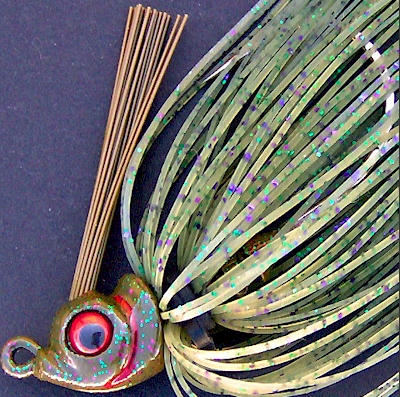
Bassdozer Heavy Duty Flip 'n Swim Jig ~ Watermelon Candy
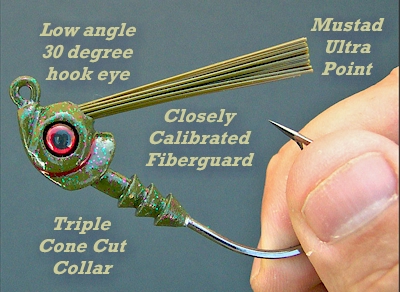
- Low Angle 30 Degree Hook Eye. Unlike conventional
jigs, the 30 degree bend jig hook is what helps make these jigs
swim better than a jig with a traditional 60 degree or 90 degree
jig hook. The 30 degree hook placement and the curve of the chin
underneath it help bring the jig though grass better than other
jigs, plus the collar (where the skirt goes) is much lower below
the jig's center of gravity, which helps steer the eye over and
through grass, helps the point stick on a strike and helps
counterbalance the jig to stay upright when swimming. I've seen
many ill-balanced flipping jigs that roll over on their sides
when you try to swim them, and I've seen many swimming jigs just
too light to flip - but the Flip 'n Swim jig swims and flips in
grass better than most other flipping jigs out there, and it
swims better than most other swimming jigs out there today.
- Premium Mustad Ultra Point Jig Hook. 5/0 with a black
nickel finish and an Ultra Point designed to resist the point
bending and rolling over when it meets gristly mouth material.
This is one of Mustad's newest - and best - jig hook models. New
hook models like this have a habit of leapfrogging over old hook
models. Let's face it, you can't upgrade an old hook model since
they are many existing molds and lure manufacturers worldwide
depending on hook models to remain consistent. But you can learn
what makes a jig hook better, and incorporate those ideas into a
new hook model, which is what Mustad did with this hook. Every
dimension is better than most any flipping jig hook built before
it. The total length from the eye to the bend is longer than any
flipping jig hook I know. Just like long shank hooks have become
preferred on spinnerbaits, this new longer jig hook also puts the
hook point back further into the mouth when engulfed - and also
puts the hook point further back to hook more short-striking
fish. The top of the hook eye is much lower than the point, thus
less impediment caused by protruding hook eye blockage on the
hookset. The "front length" (distance from the tip of
the point to back of the bend) is longer, for more cant and
leverage on the hookset. From the tip of the point to the barb is
longer, for more tentative hold upon initial penetration. The
bend is wider, the gape is wider and the bite or throat is
deeper. As I say, every dimension is designed better than most
any flipping jig hook built before it. New hooks designs tend to
be like that. It has a heavy flipping strength hook wire for
landing big bass with medium/heavy to very heavy tackle.
The Mustad Ultra Point is also revolutionary for flipping jigs.
Mustad came out with it a few years back. It is super-sharp right
out of the box, but where it excels most is after a few fish are
caught or after you've been flipping a few hours or all day. The
tip of the point rarely bends. The Mustad Ultra Point holds its
point better under hard flipping conditions and doesn't roll the
point after a few fish or flipping tough stuff all day.
Best of all, the huge hook gap can accommodate big trailers and
still have enough hook gap left to hook and land fish well. The
huge hook gap assures your hookset will take, even at the end of
a long flip or pitch, or long distance cast when swimming the
jig.
This is a modern hook made to withstand the force of superlines
(braid), but works equally swell with monofilament or
fluorocarbon. That doesn't mean it will never bend under
tremendous pressure of heavier braided lines, but it is designed
to bend less than most other flipping hooks do. No matter how
strong a heavy duty flipping hook looks and feels, most all can
and will bend under intense pressure with heavy braid.
- Closely Calibrated Fiberguard. The fiberguard is
painstakingly calibrated to need no trimming. It wasn't so many
years ago, there was practically only one size fiberguard, and it
came the maximum length, very thick and very stiff, sort of a
"one size fits all" which often meant that savvy
anglers would need to trim, shorten and thin out some fibers to
tailor the fiberguard to be just right for the snags they faced.
Worst of all, less experienced anglers would use the fiberguard
as is, and have problems hooking fish. No wonder novices would
say jig fishing is hard to master. Remember, a fiberguard is only
there to let the jig traverse terrain that an exposed hook can
not. Nowadays, a manufacturer can practically custom order the
length, stiffness, fiber diameter and number of fibers in a
bundle that they desire. So we perfectly configured the
fiberguard on the Style T jig so it does not need trimming. It's
good to go right out of the box, and hooks a high percentage of
fish while avoiding snags. Even inexperienced anglers will hook a
lot of fish - and remarkably avoid snags like they're experts!
You do want to fan the fibers out, just a little bit on both
sides, to serve as side deflectors to usher the hook away from
grass and snags from the sides. But you do not need to trim it.
It is set up for grass and weeds and brush, and that's why the
fiberguard is a little longer which helps the jig get through
grass. However, if you fish relatively snag-free areas, you may
want to clip 1/4" off the tip of the fiberguard. This is
just to lower the protruding tip of the fiberguard, so it reduces
any chance it's an impediment when a fish engulfs it.
- Triple Cone Cut Keeper Collar. This is something you
do not see much yet on bass lures. The Style T jig here is just
about the first to implement it (on bass jigs). It is designed to
hold a skirt (over the first cone) and the remaining two cones
can hold a soft trailer securely. To get a skirt or soft bait
onto the cones, it's best to wet the collar a little first. Lake
water or any water will do. At home, I like to use a Q-Tip dipped
in water and dishwashing liquid. Just dab the cones to wet them,
then wriggle the skirt or soft bait gently side to side to get it
seated properly on the cones. If you try it dry or apply too much
direct force straight ahead, it's not as easy and results will be
less than perfect. Wet the cones, and wriggle side to side
gently, and your skirt and/or soft bait will enjoy the benefit of
360 degree all-around grip from each of the three cones. All
together, that's 1,080 degrees of gripping power. Much better
than a puny barb or bent wire keeper!
The triple cone cut keeper collar is a significant advantage.
First, there is one keeper cone for the skirt, and it is quite
difficult for a fish to ever pull the skirt down. Second, there
are two more cone keepers with a full 360 degrees of gripping
power each (a total of 720 degrees of grip strength) that helps
hold a soft plastic trailer far more securely than any spike or
barb type keeper. Do the math. A spike or barb type keeper has at
most 15 degrees of grip whereas the Style T jig has 720 degrees
of grip. It's obvious the Style T will hold soft baits much more
securely. Worst of all, most other flipping or swimming jigs on
the market have absolutely no way to hold soft plastic trailers -
just a bare hook shank behind the skirt! The Style T has not one
but two full 360 degree trailer keeper cones!
Rigging Methods
This jig comes through grass weedless and snagless, better
than any flipping jig I know. Try it and see for yourself. At the
same time, it is designed to momentarily clutch grass. I love the
way it grabs but let's go of grass. There's something fish find
perfect about that at times. We often hear how fishing lipless
rattling crankbaits (or any lure) in grass, how it's good to rip
it off grass to get a strike. Well, this jig does that - briefly
- so fast it is hardly noticeable. It acts more like an aquatic
terrestrial creature, an amphibian, waterbug, larvae or crawdad
that moves from stalk to stalk, briefly clutching on and pushing
off to the next stalk. Once you know about this unique
grab-and-go action, you'll find yourself intentionally fishing
this jig to bring that action out of it.



Shown rigged with:
- Yamamoto 97-series double tail hula grub (top)
- Yamamoto Kreature (center)
- Yamamoto 97-series double tail hula grub (bottom)
Please enjoy! |
